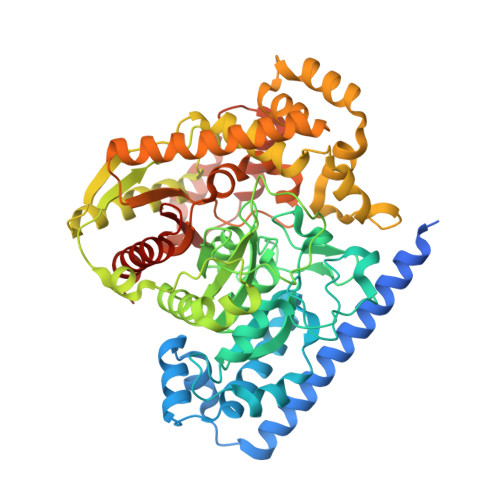Structure-Guided Inhibitor Design for Human Faah by Interspecies Active Site Conversion.
Mileni, M., Johnson, D.S., Wang, Z., Everdeen, D.S., Liimatta, M., Pabst, B., Bhattacharya, K., Nugent, R.A., Kamtekar, S., Cravatt, B.F., Ahn, K., Stevens, R.C.(2008) Proc Natl Acad Sci U S A 105: 12820
- PubMed: 18753625
- DOI: https://doi.org/10.1073/pnas.0806121105
- Primary Citation of Related Structures:
2VYA - PubMed Abstract:
The integral membrane enzyme fatty acid amide hydrolase (FAAH) hydrolyzes the endocannabinoid anandamide and related amidated signaling lipids. Genetic or pharmacological inactivation of FAAH produces analgesic, anxiolytic, and antiinflammatory phenotypes but not the undesirable side effects of direct cannabinoid receptor agonists, indicating that FAAH may be a promising therapeutic target. Structure-based inhibitor design has, however, been hampered by difficulties in expressing the human FAAH enzyme. Here, we address this problem by interconverting the active sites of rat and human FAAH using site-directed mutagenesis. The resulting humanized rat (h/r) FAAH protein exhibits the inhibitor sensitivity profiles of human FAAH but maintains the high-expression yield of the rat enzyme. We report a 2.75-A crystal structure of h/rFAAH complexed with an inhibitor, N-phenyl-4-(quinolin-3-ylmethyl)piperidine-1-carboxamide (PF-750), that shows strong preference for human FAAH. This structure offers compelling insights to explain the species selectivity of FAAH inhibitors, which should guide future drug design programs.
Organizational Affiliation:
The Skaggs Institute for Chemical Biology, La Jolla, CA 92037, USA.

















